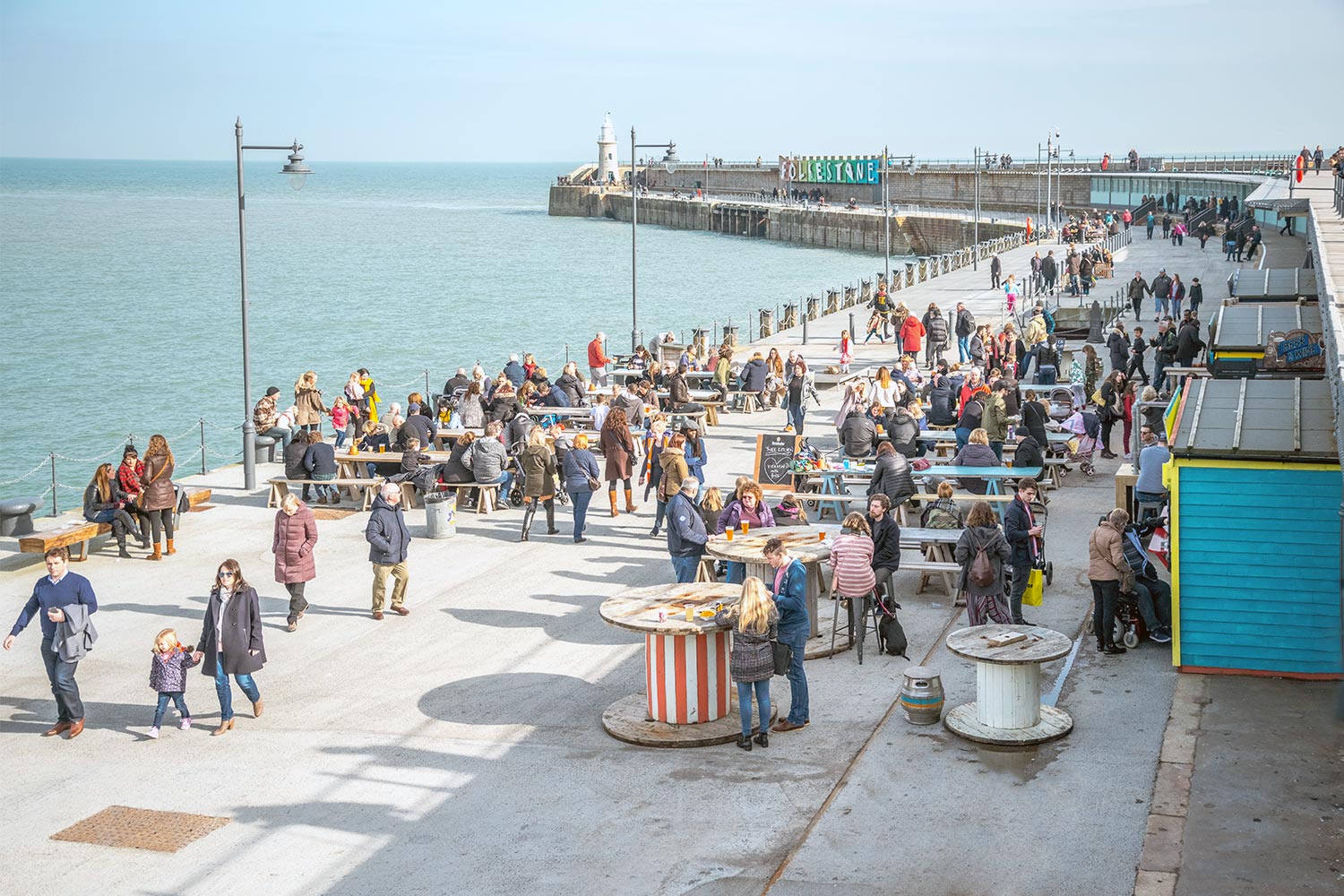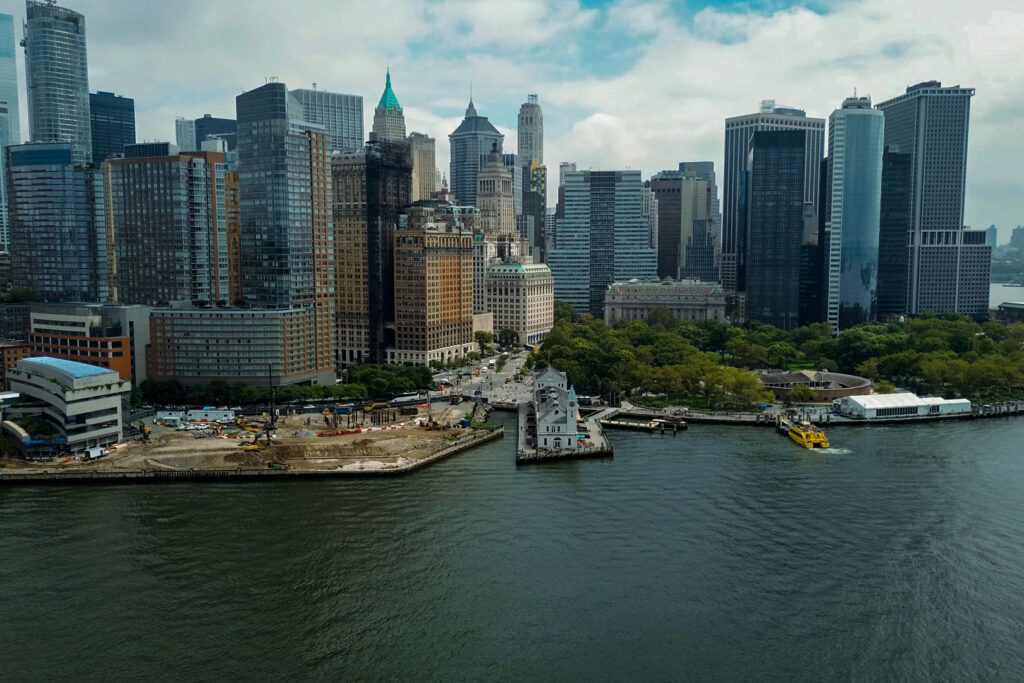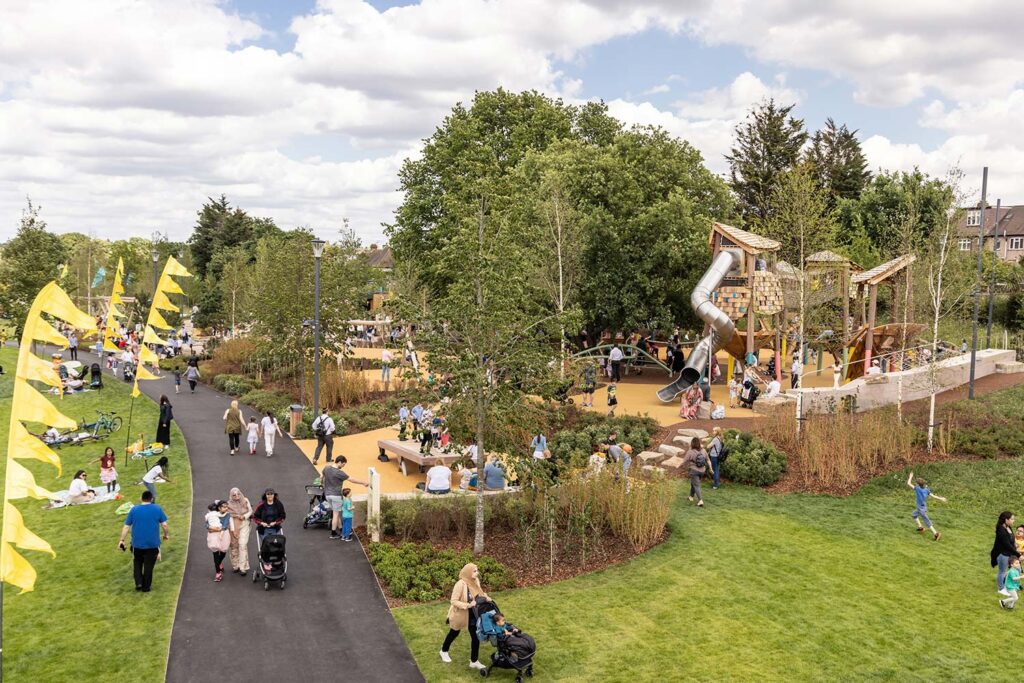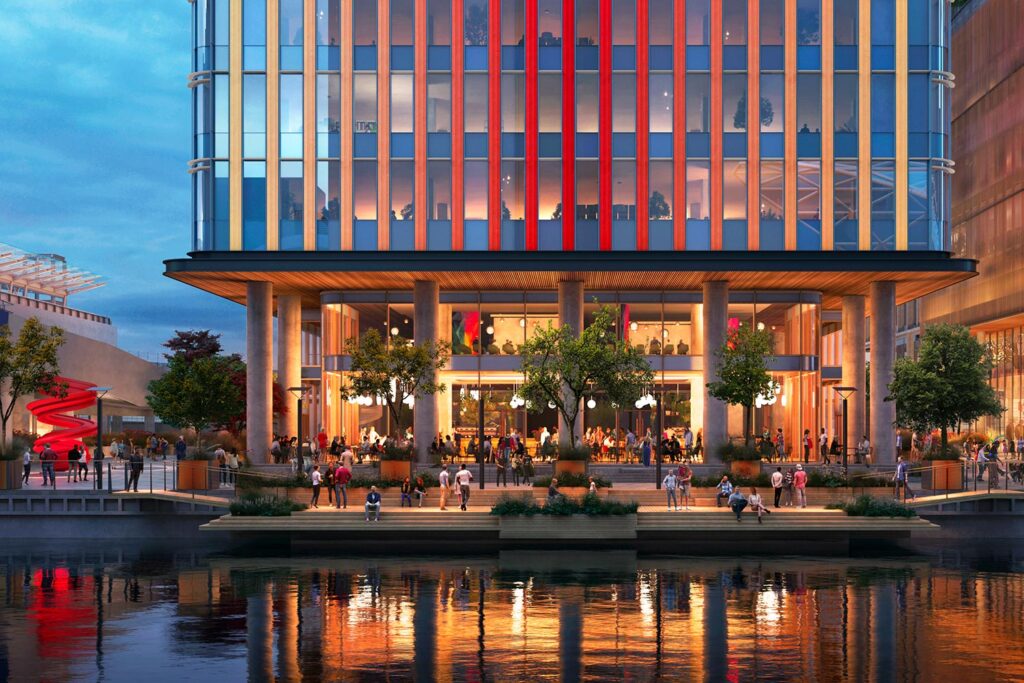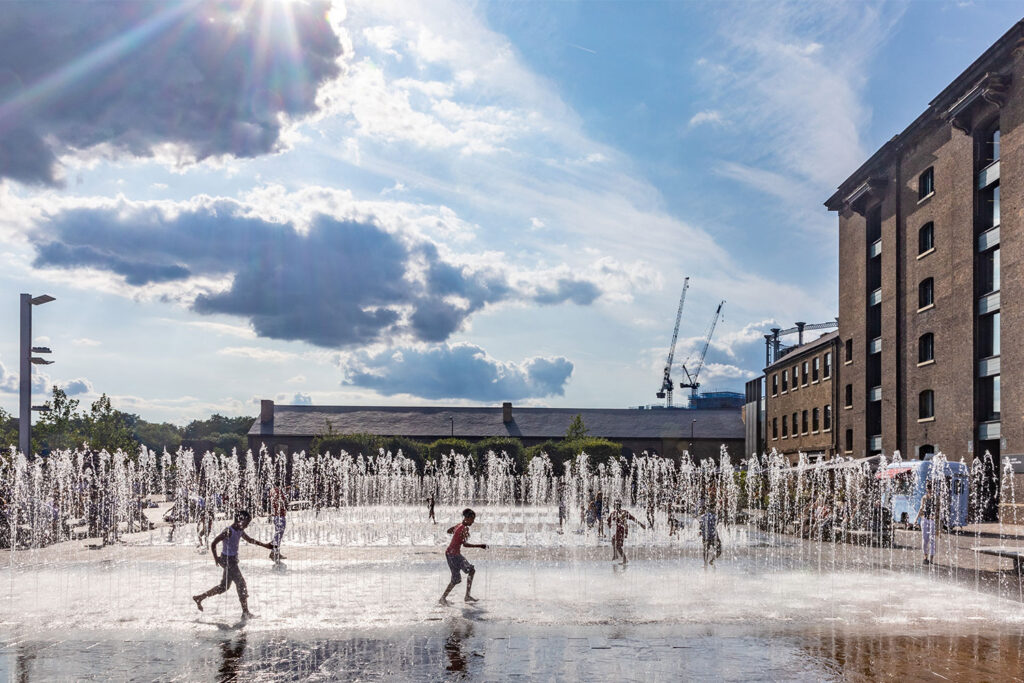
Folkestone Harbour
Folkestone, UK
Project details
Client
Folkestone Harbour (GP) Limited
Architect
Terry Farrell and Partners and ACME
Duration
2009 – ongoing
Services provided by Buro Happold
Coastal and maritime engineering, Economics, Environmental consultancy, Ground engineering, Infrastructure, Structural engineering, Transport and mobility, Water
Buro Happold is playing a leading role in the regeneration of Folkestone Harbour. Sir Roger De Haan purchased the harbour in 2004. His vision was to develop the area into a high-quality residential and commercial development that will serve as both a legacy and a catalyst for further regeneration of the town where he was born.
This ambitious project is now coming to fruition. Buro Happold has provided a full spectrum of technical services for this exciting development, ranging from masterplanning to structural design economics to flood defence. Our team has been the only constant presence throughout the enterprise – a technically excellent, provoking, and collaborative partner, enabling the Folkestone Harbour vision to come to life.
Challenge
The viability of the project has always been in the balance because of concerns about flood risk and the consequently high cost of building sea defences needed to mitigate this threat.
Under extreme storm conditions, the site was at risk from sea flooding; a risk that will only increase with expected rises in sea levels as a consequence of climate change. The flood protection required to protect the development needed to minimise capital costs, whilst also increasing the economic and social value of the development. It was clear that a successful flood defence strategy was the key to unlocking this exposed site.
The harbour estate included a derelict railway viaduct, station and breakwater extending 500m into the deep waters of the English Channel. This had a poignant role in the First World War as it was where many soldiers departed for France. All of these structures were derelict, unsafe and closed to public access. This provided both a risk and opportunity to the project; a legacy of under-investment required significant investment but offered the opportunity of place-making – creating a vibrant historic commercial quarter from which the rest of the development would springboard.
As well as this place-making enabling work, our teams were engaged to provide multidisciplinary engineering design support across the phase one residential scheme, known as Shoreline Crescent.
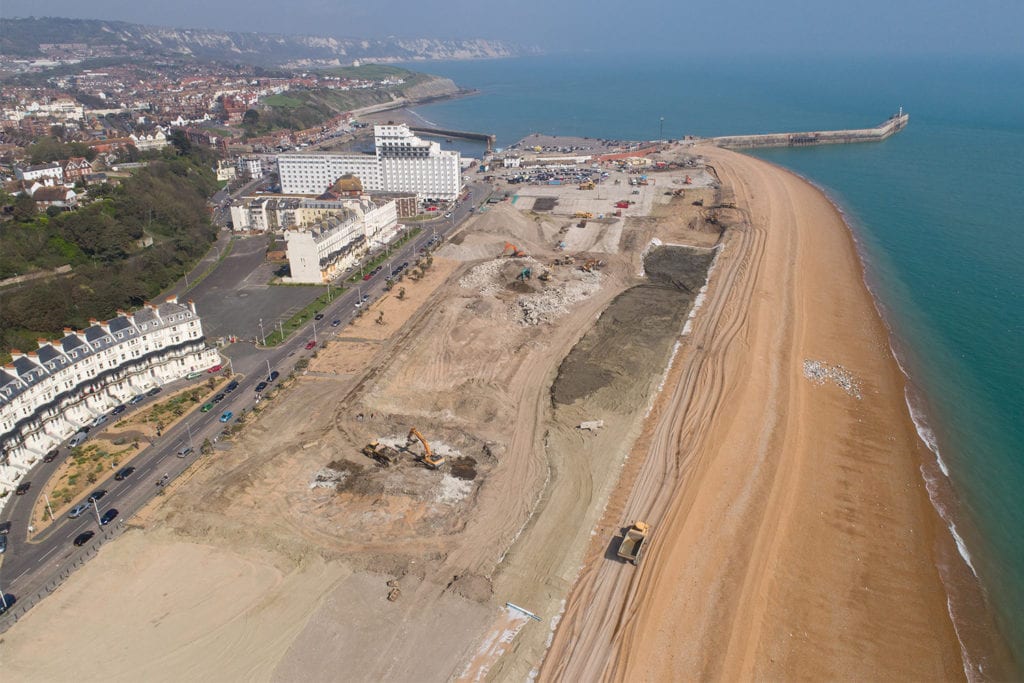
Solution
Buro Happold has been pivotal in solving the harbour’s challenges through two initiatives. The first was the promotion of an innovative flood defence strategy, accepted by the Environment Agency, which adopted cost-effective solutions harnessing the site’s natural resources and working with natural beach processes. By excavating the reservoir of natural beach shingle that laid under the development site, the beach was increased in height and width, providing a reinforced sea defence. This shingle will be proactively maintained over the lifetime of the development to sustain the sea protection and amenity value. This avoids the need for ‘hard’ sea defences such as concrete seawalls. The residents will have open and immediate beach access, and yet be safe from storm waves and the effects of sea level rise.
The hole left by the shingle excavation from the development site was filled with sand dredged from the harbour. This has enabled a long-held desire of the fishing and leisure boat communities for a deeper outer harbour, increasing tidal access time. The project only recycled existing site-won sand, shingle, and hardstanding, eliminating the negative environmental and economic impacts of importing or exporting materials. Our experts designed, procured, and supervised the ensuing earthworks, delivering a near 50% reduction from the original cost plan. The cost reduction was in great part achieved by our procurement strategy and management of the construction contracts.

Our economics team successfully submitted a business case to the Local Enterprise Partnership for the project. This secured public part-funding for both the flood defence works, and works to restore the railway station and viaduct. The latter created an 800m-long open public space with thriving food and beverage outlets, which hosts popular public events. This was work we designed, procured, and supervised.
The renovation of structures often more than a hundred years old, exposed to the aggressive saltwater climate of the sea, presented an additional challenge which was effectively overcome by our team.
These two projects create the physical and social foundation from which the wider residential and commercial development could be built. A full spectrum of building engineering technical services was delivered to enable the commencement of the first phase of residential development.
The first phase, Shoreline Crescent (Plot B), is a landmark seafront residential block of apartments, duplexes and town houses, which forms a crescent along the coastline. Our multidisciplinary team advised on everything from structural engineering to building services engineering (MEP), providing insight from most of our specialist teams.
We worked closely with the architect to inform a flood-resilient design, particularly for the basement parking. This is sited on the town side, just half a floor below ground level, beneath a raised garden, which sits at the hub of the crescent. This ensures it is within the agreed planning level to mitigate against potential flooding scenarios.
The crescent design itself maximises sea views for residents, supported by an intricate interlocking over-sail structure to the town houses, which allows their main living spaces to overlap with their neighbour’s house, expanding the views towards the sea. As well as being an unusual structural challenge, this also required complex MEP servicing strategies.
Careful consideration also had to be given to materiality, to maximise the life of the development in the face of potentially wearing salt air, marine conditions. A ceramic facade provides an extra layer of protection to the outer walls. The masonry wall ties are made from the same marine-grade stainless steel used on oil rigs, while railings and balustrades are fabricated from marine-grade powder-coated aluminium.
The drainage strategy for the site focused on utilising the high infiltration rates along the southern side with a soakaway and having permeable paving to make up the surface of southern service road. The soakaway, placed below the surface, will discharge 83% of the roof water run-off from the development, as well as the rainfall on the permeable paving above it.

Value
This is a diverse and complex project that showcases Buro Happold’s multifaceted skills, at both building scale and beyond. The work we carried out on Folkestone Harbour celebrates the town’s poignant history, opening it up to both residents and visitors for years to come. The area is now the hub that the wider residential and commercial development will revolve around, spurring the regeneration of the rest of the town.
The project is proudly ‘non-standard’, with the aim of providing a suitable legacy for the town, client, and spectacular site. The development will challenge preconceptions about seaside property development, with Buro Happold at the forefront of the technical design.
Phase one has completed and our teams are supporting the client with technical advice and planning support on future phases. This ranges for input on sea defences and beach management to transport strategies.
